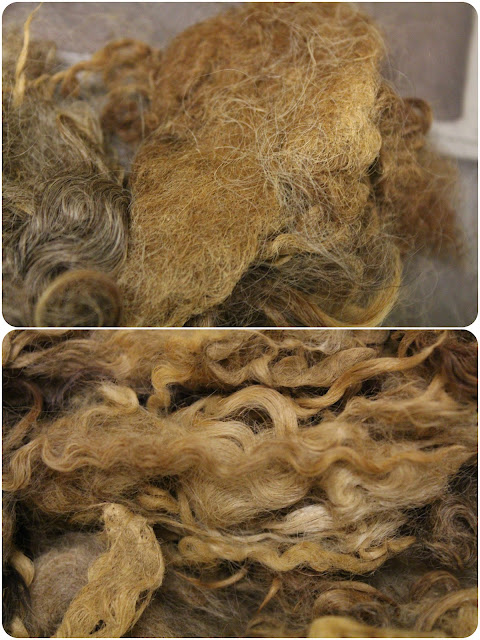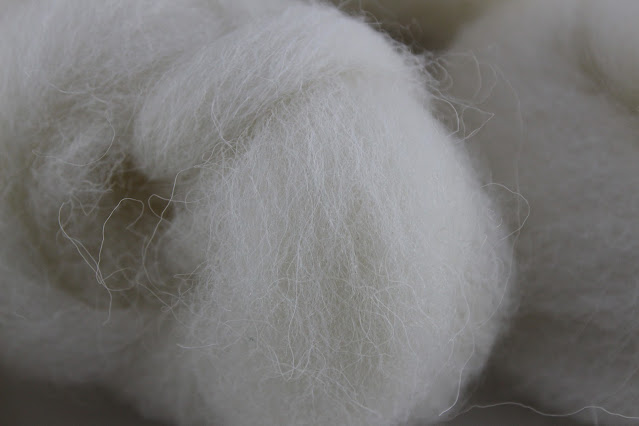The Leicester Longwool has been around since the 1790's having being improved from the now extinct Dishley Leicesters that were developed by Robert Bakewell from the local landrace breeds. He was the man who introduced the idea of "a breeding season" and keeping rams and ewes separate to allow for selective breeding of desirable traits and also the idea of the breed assocation for each breed of sheep. Robert's Dishley Leicesters died out soon after his death in 1795. In turn, the Leicester Longwool breed is the pre-cursor and direct ancestor of both the Border Leicester and the Bluefaced Leicester.
The Leicester Longwool sheep used to be the most common breed in England but now it is critically endangered, at the time of writing, is in the Rare Breeds Survival Trust category 3: Vulnerable (500-900) registered breeding ewes. They are very rare these days but are still most popular in the East Midlands, where the breed originates from.
The Leicester Longwool is a large, hornless sheep with wool on the crown. It has a white face and legs, a slightly Roman nose and the nostrils are dark and it grows a heavy even fleece. They produce a large size fleece that weighs 2.3kg-8.2kg with staples that are 10-14 inches long (25.5cm-35.5cm). Sometimes they are sheared twice a year so that the staple length would be more manageable.
The fleece is dense, silky and lustrous with a soft handle. The locks hang individually with a well defined crimp or wave over the entire lock. Coloured patches in a white fleece are not acceptable and the white fleece needs to be protected from this genetic mechanism. Coloured fleece are acceptable but they must be coloured all over and not coloured patches on a white fleece. Fleece should be wholly white or wholly coloured and the colours are white, black or "English Blue" which is a multi-shaded shaded grey
This fleece is usually too long to be cards but can be spun from teased locks, picked, flicked or combed. Keep your hands well separated when spinning and when drafting hold it very lightly and keep re-arranging the mass of fibre to keep it flowing evenly and smoothly. White fleece takes dye clearly and the high lustre makes colours pop. The English Blue can also be dyed.
Yarns spun from Leicester Longwool fleece will be strong and is good for lace patterns as it gives excellent stitch definition. Might not be suitable for next-to-skin use but a shawl or wrap would be perfect.
I had a lot of trouble locating any fleece or fibre from this breed due to its rarity and I finally found some and bought this breed in as 450g of raw fleece but I ended up getting it from someone selling it on Ebay, which can always be a bit hit and miss. There weren't many photos and they weren't the best quality, obviously taken with a mobile phone without much care, but there were a couple of photos of the sheep the fleece had come from and I was happy to accept that it was a coloured Leicester Longwool sheep so I took a punt and hoped for the best.
 |
| Parts of the fleece was very dirty and sticky with grease |
 |
| Matted and dry, brittle parts of the fleece. |
I wasn't totally happy with the quality of the fleece when it arrived and I inspected it with great care to see what the issue was. There was a few clumps that were just a matted/felted mess and then were was parts that were very dry and brittle, almost like old paper, and just touching it to gently tease the locks apart without any pulling made it just break into tiny bits. It basically disintegrated in my hands. I washed everything else, which was 329g out of the original 450g. I did contact the seller, who took no responsibility for the condition of the fleece whatsoever and claimed it was freshly sheared, although its a bit early in the year for shearing, and blamed me for the damaged fleece.
 |
| Interesting colours! |
I combed the fleece when it was dry and I got some very interesting and very differently coloured hand combed nests that weighed a total of 153g. Whilst it would have been fun to spin this up and see what the end yarn looked like I decided to put it through my blending hackle to even out the colour and produce an even coloured yarn.
My finished yarn is of medium quality to the touch of the hand and only slightly prickly, as many longwools are due to the fibre type, but I do like the colour now that it's even. It's more of a dense yarn as opposed to being light and bouncy. This is obviously the English Blue and there is 125g/195m. My knitted piece for the project only took 50g/78m so I have some left to do whatever with.















































